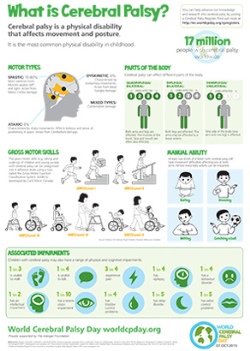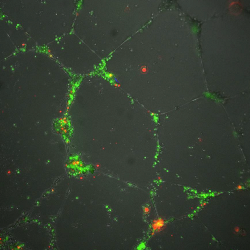You are here
Multiple Doses of Cord Blood are Better for Cerebral Palsy in Animal Model
Cerebral palsy (CP) affects over 17 million people worldwide and is the most common form of physical disability in childhood1. CP is caused by damage to the developing brain either during pregnancy or around the time of birth. CP disability can range from mild motor coordination dysfunction through to significant hemiplegia (one or two limbs on one side of the body) or quadriplegia (4 limbs affected on both sides of the body).
Unfortunately, the physical motor disabilities that define CP often coexistent with other serious deficits. For example, 1 in 2 children with CP have intellectual disabilities including cognition, memory, learning and behaviour deficits, 1 in 4 have epilepsy, 1 in 4 cannot talk, and 1 in 4 are incontinent2. Parents of infants with CP are actively seeking new treatment options, including the use of stem cell therapies, particularly umbilical cord blood3-5. A survey in 2010 ranked CP as the 2nd most commonly treated condition at stem cell clinics6.
Over the last 5-6 years our research team at The Ritchie Centre, Hudson Institute of Medical Research, Melbourne, Australia, has been investigating the potential of cord blood stem cells for treating injury in the developing brain using preclinical animal models.
However, most studies to date, including ours and others, have focused on the short-term effects of cord blood and only followed up for days to weeks after treatment. We thought it was really important to look at the long-term effects and see if treatment with cord blood had long lasting effects on behavior and the brain. We decided to perform a long term follow up and assessed these effects when adolescence was reached. We found that when you give a single dose of cord blood shortly after brain injury, the long term behavioural improvement is maintained, but significant injury to the brain still occurs8.
We next investigated if multiple doses of cord blood would be more effective than a single dose for maintaining long term benefit after brain injury. This work was presented in a poster9 at the Perinatal Stem Cell Society meeting in Salt Lake City Utah, February 2019. This study was done by my very talented PhD student, Ms Tayla Penny, and is currently in preparation for publication.
The cord blood for our study was collected from healthy women who had caesarean sections and donated their cord blood for our research. We then isolate the cells from the blood and freeze them in liquid nitrogen until we need them for our studies. To model perinatal brain injury, we use a rat model where we induce injury that is similar to a baby that suffers asphyxia during labour. This insult reduces blood flow and oxygen to the brain, which we call hypoxic ischemia (HI) and this causes long term injury.
The animal model had 4 groups: one that was a healthy control; one which was an injury only group; one group that had injury and received one dose of cord blood (24 hours after injury); and one group that had injury and received three doses of cord blood (24 hours, 72 hours, and 7 days after injury). Results of the study were measured with behavioural tests on the rats until they reached an age equivalent to human adolescence.
As expected, we found that the brain injury caused significant reduction in the overall behaviour score compared to our healthy group. This behavioural deficit was significantly improved with multiple doses of cord blood, but not with a single dose. We also showed that the injury caused significant loss of brain tissue and cell death, which was only improved in the study arm that administered multiple doses of cord blood cells.
We are hoping that results from our work will help improve the design of human clinical trials that are testing cord blood for perinatal brain injury and cerebral palsy. Eventually, we hope to improve the long term outcomes for children and families living with CP.
References
- Facts about Cerebral Palsy from CP Alliance
- Novak I, Hines M, Goldsmith S, Barclay R.2012. Clinical prognostic messages from a systematic review on cerebral palsy. Pediatrics, 130(5):e1285-312.
- Min K, Song J, Kang JY, Ko J, Ryu JS, Kang MS, Jang SJ, Kim SH, Oh D, Kim MK, Kim SS & Kim M. Umbilical Cord Blood Therapy Potentiated with Erythropoietin for Children with Cerebral Palsy: A Double-blind, Randomized, Placebo Controlled Trial. 2013. Stem Cells, 31(3):581-591.
- Kang M, Min K, Jang J, Kim SC, Kang MS, Jang SJ, Lee JY, Kim SH, Kim MK, An SSA, & Kim, M. Involvement of Immune Responses in the Efficacy of Cord Blood Cell Therapy for Cerebral Palsy. 2015. Stem cells and development, 24(19):2259-2268.
- Sun JM, Song AW, Case LE, Mikati MA, Gustafson KE, Simmons R, Goldstein R, Petry J, McLaughlin C, Waters‐Pick B, Chen LW, Wease S, Blackwell B, Worley G, Troy J, & Kurtzberg J. Effect of Autologous Cord Blood Infusion on Motor Function and Brain Connectivity in Young Children with Cerebral Palsy: A Randomized, Placebo‐Controlled Trial. 2017. Stem Cells Translational Medicine, 6(12):2071-2078
- Zarzeczny A, Rachul C, Nisbet, M, Caulfield, T. 2010. Stem cell clinics in the news. Nat Biotechnol, 28, 1243-6.
- MCDONALD, C. A., PENNY, T. R., PATON, M. C. B., SUTHERLAND, A. E., NEKKANTI, L., YAWNO, T., CASTILLO-MELENDEZ, M., FAHEY, M. C., JONES, N. M., JENKIN, G. & MILLER, S. L. 2018. Effects of umbilical cord blood cells, and subtypes, to reduce neuroinflammation following perinatal hypoxic-ischemic brain injury. Journal of Neuroinflammation, 15:47.
- PENNY, T., SUTHERLAND, A., MIHELAKIS, J., PATON, M., PHAM, Y., LEE, J., JONES, N., JENKIN, G., FAHEY, M., MILLER, S. & MCDONALD, C. 2019. Human umbilical cord therapy improves long-term behavioural outcomes following neonatal hypoxic ischemic brain injury. Frontiers Physiology, 10:283.
- PENNY, T., SUTHERLAND, A., MIHELAKIS, J., PHAM, Y., LEE, J., JENKIN, G., FAHEY, M., MILLER, S. & MCDONALD, C. 2019. Repeated doses of umbilical cord blood cells improve perinatal brain injury. Perinatal Stem Cell Society poster presentation


 Image description: This live cell imaging was captured by Dr. Courtney McDonald with a confocal microscope. It shows cord blood cells (red) interacting and communicating with blood vessel cells (green), which suggests one mechanism by which cord blood cells can help the brain.
Image description: This live cell imaging was captured by Dr. Courtney McDonald with a confocal microscope. It shows cord blood cells (red) interacting and communicating with blood vessel cells (green), which suggests one mechanism by which cord blood cells can help the brain. This work is very exciting because it is the first evidence that multiple doses of cord blood are better for improved long term outcomes.
This work is very exciting because it is the first evidence that multiple doses of cord blood are better for improved long term outcomes.